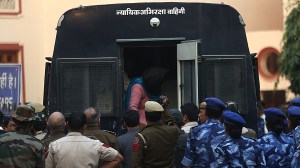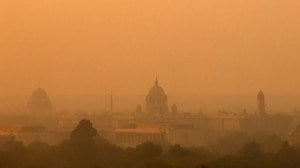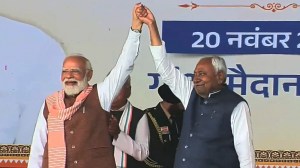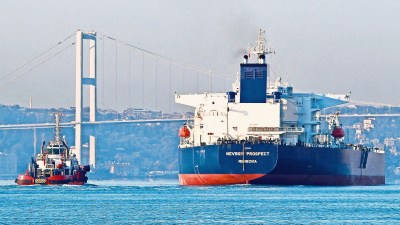In flood-hit Punjab where currently boats are the only lifelines to rescue people and deliver basic aid in submerged villages, the shortage of government boats has severely hit the relief operations.
The NGOs and other philanthropic organizations working on the ground have alleged that most of the sarkaari boats owned by the Punjab government were busy ferrying ministers, MLAs to flood-hit villages, so they were buying their own motorised boats to carry out relief works.

The data accessed by The Indian Express from Punjab government’s department of revenue, rehabilitation and disaster management reveals that the state has 257 boats for 23 districts to respond to emergency situations but just 114 of them can be motorized. This, even as the state has three perennial rivers (Ravi, Beas and Sutlej) and remains flood prone every monsoon.
 Manish Sisodia visiting flooded areas
Manish Sisodia visiting flooded areas
A total of 257 boats translates to an average of 11 boats per district. However, since there are only 114 engines available with the government, only as much boats can be run in motorised mode which is a prerequisite in floods to ensure speedy rescue and relief operations.
Of 257 boats available with the Punjab government, 127 are made of metal and 83 fibre/other materials which the rescuers say are “heavy and get stuck often”. The government has just 47 inflatable boats which “work best in situations like floods.”
“Manual boats without motors just can’t work in floods as they require a lot of physical effort and time which delays rescue and relief,” said a rescuer.
Other than Punjab government-owned boats, the National Disaster Response Force (NDRF) and the Indian Army are having their own boats for relief operations.
Story continues below this ad
 A total of 257 boats translates to an average of 11 boats per district. However, since there are only 114 engines available with the government, only as much boats can be run in motorised mode which is a prerequisite in floods to ensure speedy rescue and relief operations.
A total of 257 boats translates to an average of 11 boats per district. However, since there are only 114 engines available with the government, only as much boats can be run in motorised mode which is a prerequisite in floods to ensure speedy rescue and relief operations.
Uneven distribution
The district-wise data of the boats further reveals they are unevenly distributed. The districts worst-hit by floods and situated near the rivers are having lesser boats compared to landlocked ones, and in some cases, if districts have boats, they don’t have enough engines.
For instance, among the districts worst-hit by floods, Amritsar has just four boats and two engines, Fazilka 32 boats but just 2 engines, Gurdaspur 7 boats and 4 engines and Kapurthala 7 boats but not a single engine. Pathankot has 4 boats but 2 engines, Nawanshahr has 12 boats but just 3 engines and Hoshiarpur has 11 eleven boats and 5 engines. The border district Tarn Taran has just one boat but 3 engines while Ferozepur has 30 boats and 19 engines. Jalandhar has 10 boats but only 3 engines.
On the other hand, Mansa which has been comparatively less hit by floods, has 27 boats and 19 engines, Patiala has 52 boats and 32 engines while Sangrur has 12 boats and 3 engines. Mohali has 6 boats but not a single engine, Muktsar has four boats but no engine and Ludhiana has 12 boats and 4 engines. Malerkotla is the only district which neither has a boat, nor any engine.
Celebrities step up to do “boat sewa”
Gauravdeep Singh from Ludhiana, whose NGO “Initiators of Change” has undertaken relief works in Ajnala, Fazilka and Ferozepur, said that the waters in the villages were so deep that it wasn’t possible to reach a single house without a boat.
Story continues below this ad
“Most of the sarkaari boats are occupied in making rounds for ministers, MLAs, local politicians etc who keep visiting flooded villages for photo-ops. We cannot blame district administrations as they have to follow a protocol if any MLA or bureaucrat visits the flooded areas,” said Singh.
He added that his teams were now working in three districts with one boat each, after Punjabi singer Karan Aujla and lyricist/producer Bunty Bains responded to his appeal for help. “Aujla and Bains gave us funds for one boat each and we have bought a third one with donations from sangat,” he added.
Rattan Dhillon, another volunteer working in Gurdaspur and Fazilka districts, said: “The situation in Fazilka is just so bad. There is so much standing water in villages that vehicles can’t go inside. We had all the supplies and relief material but no boat. When we contacted the authorities, they said boats were being arranged. Similar thing happened in Gurdaspur but there the situation was still manageable. We have arranged a rafting boat on our own from Chandigarh to distribute essentials in Fazilka. But more boats are still urgently required.”
Amarpreet Singh, from the Global Sikhs, leading rescue works in flood-hit districts said that they have arranged eight boats via donations to distribute relief material and rescue people.
Story continues below this ad
“MLA said boat can’t leave without him”
Punjabi singer Jasbir Jassi who is on the ground for relief works, said that popular stand-up comedian Kapil Sharma has also done “boat sewa” as they were immediately required in the field.
Jassi alleged that politicians were in fact “hampering” the relief works. Sharing his experience he said: “Three days ago, we had arranged a boat but the local SDM got a call from an MLA that the boat will operate only when he also arrives. They are just doing it for reels and photos as they have to show people what they are doing. Some people shoot a video or a reel if they handover something worth Rs 100 to a victim and put it on social media. This hurts me emotionally. This is not a mela (fair) going on. How will those victims feel later when they will see their videos? If you are helping, don’t make a spectacle of it.”
In some villages, locals are also using makeshift boats made using rubber tyres or wooden behris to reach waterlogged areas.
Meanwhile, workshops such as “Hanspal Traders” in Kapurthala have risen to the occasion and started “boat sewa” by manufacturing boats for flood-hit districts as a philanthropic gesture.
Story continues below this ad
 Number of boats owned by Punjab govt
Number of boats owned by Punjab govt
“Process on to buy new boats”
Contacted, Manvesh Singh Sidhu, Punjab secretary revenue and rehabilitation, said, “We have 114 engines so the equal number of boats available with district administrations can be run in motorized mode. Apart from state-government owned boats, the NDRF and Army are having their own boats. If the NGOs need a boat, they can get in touch with respective deputy commissioners and it will be arranged if the demand is genuine. In some cases, relief is being distributed multiple times in the same areas. We are in the process of buying nine new motorboats for Kapurthala, Taran Taran etc.”
Asked if the boats from landlocked districts can be to flood-hit ones, Sidhu said: “No district surrenders its own assets as there can be an emergency anytime. We have less boats in Pathankot as it has sufficient Army boats.”
Punjab chief minister Bhagwant Mann’s decision to handover his chopper to Gurdaspur district administration for “relief works” was dubbed as a “gimmick” by the Opposition parties, alleging that it was mostly being used by ruling Aam Aadmi Party (AAP) MLAs for photo-ops, and the food packets were being airdropped in flood waters instead of precise locations.
Recently, Punjab cabinet ministers including Laljit Bhullar, Harbhajan Singh ETO and Barinder Goyal also faced flak after they were purportedly heard discussing their luxurious cruise trips in Sweden and Goa while sitting in a boat to visit flood-hit areas.
Story continues below this ad
AAP’s Rajya Sabha MP Vikramjit Sawhney has donated motorboats with his own funds and has also arranged a chopper for relief works in Ajnala.



 Manish Sisodia visiting flooded areas
Manish Sisodia visiting flooded areas A total of 257 boats translates to an average of 11 boats per district. However, since there are only 114 engines available with the government, only as much boats can be run in motorised mode which is a prerequisite in floods to ensure speedy rescue and relief operations.
A total of 257 boats translates to an average of 11 boats per district. However, since there are only 114 engines available with the government, only as much boats can be run in motorised mode which is a prerequisite in floods to ensure speedy rescue and relief operations. Number of boats owned by Punjab govt
Number of boats owned by Punjab govt





